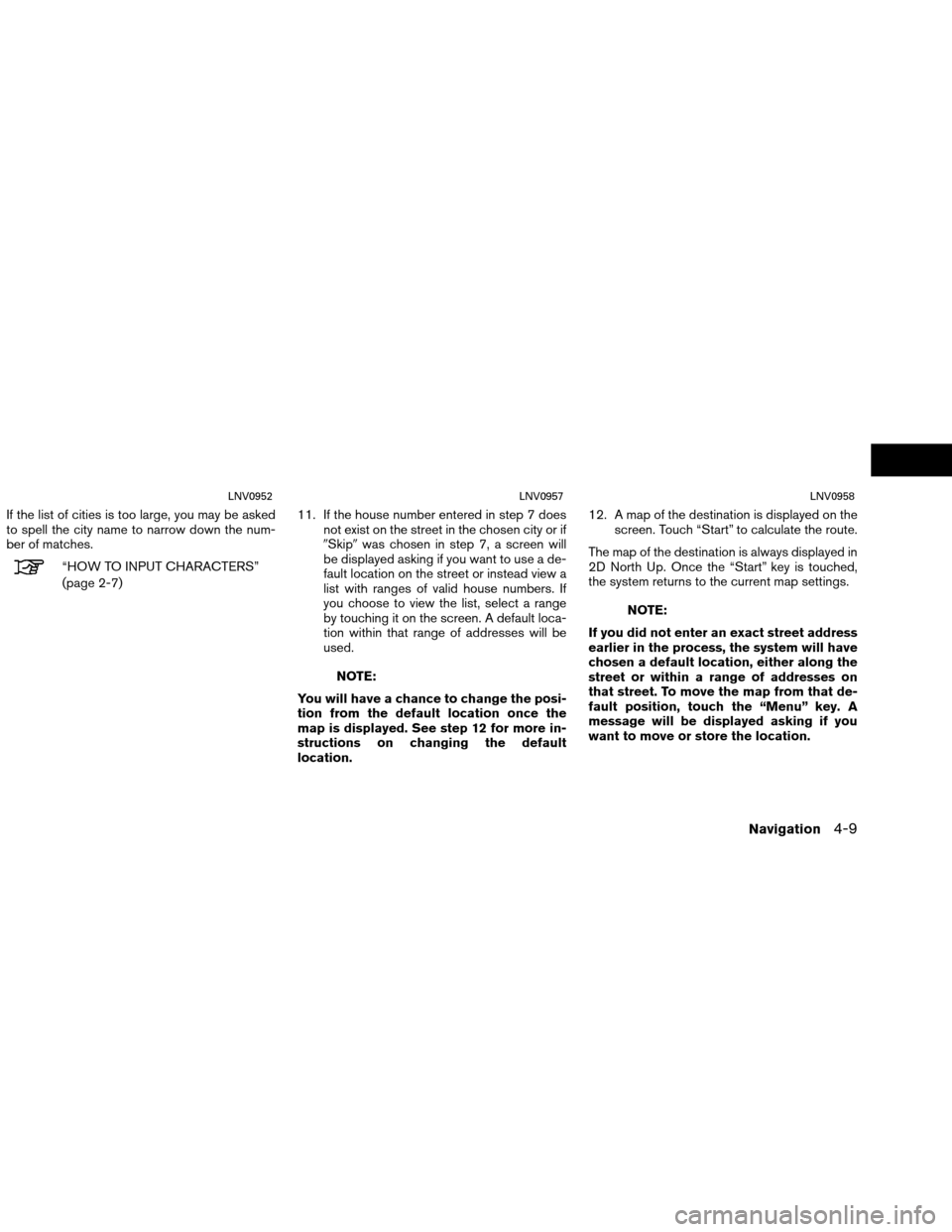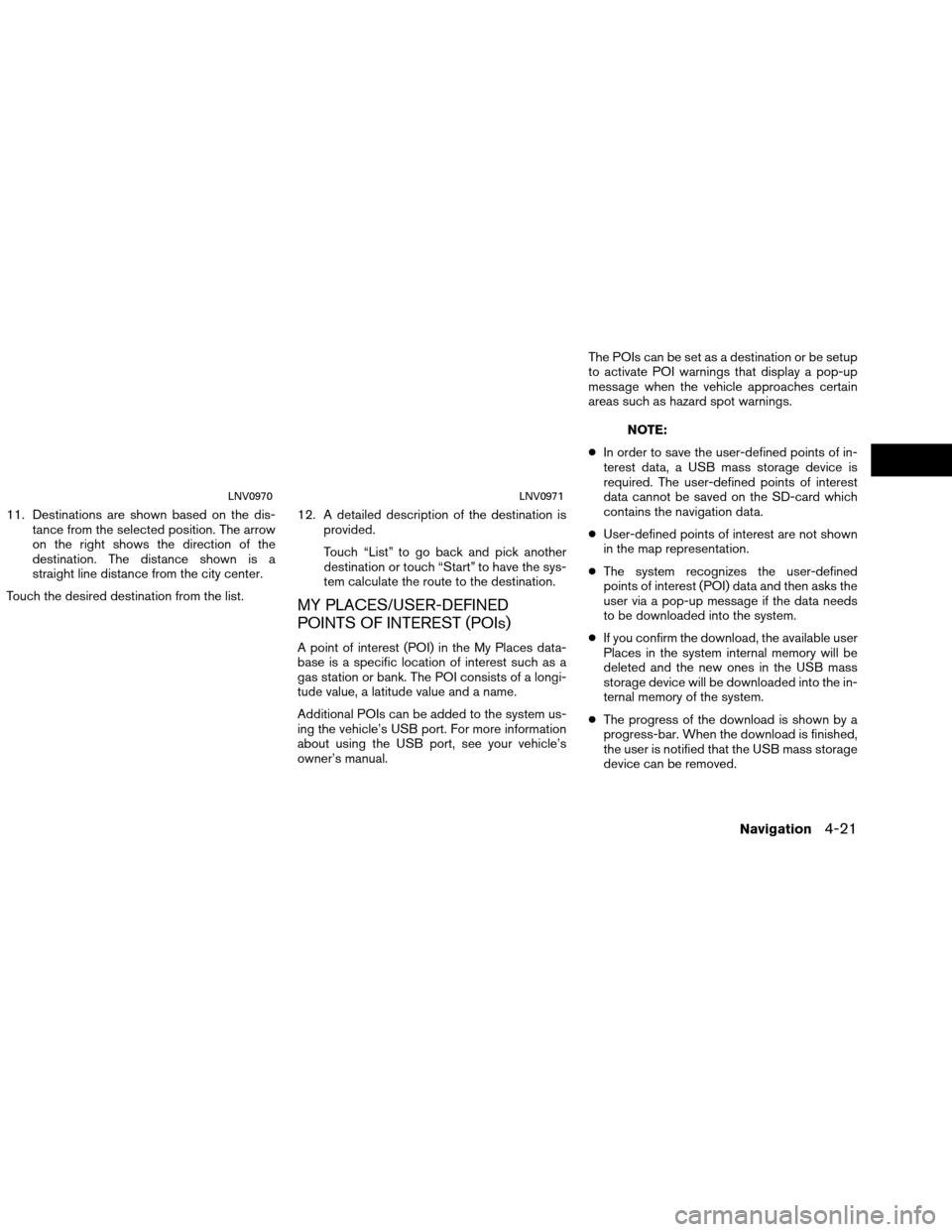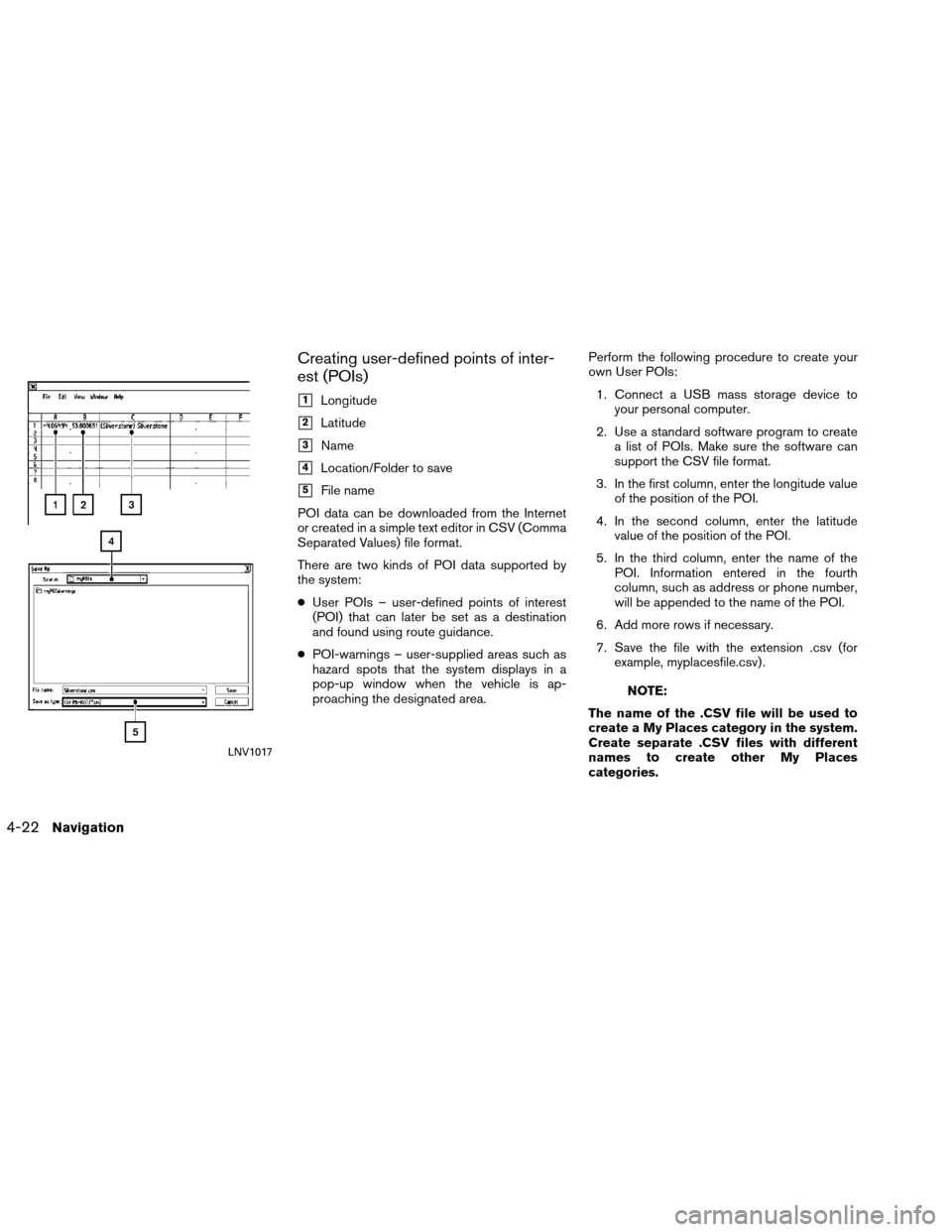Page 36 of 82
8. The display shows a touch keyboard to en-ter the street name. Enter the name of the
street. At any time, touch the “List” key to
display a list of possible street names based
on the letters currently entered. When the
number of matches is reduced to five or
less, the street list will be shown
automatically.
“HOW TO INPUT CHARACTERS”
(page 2-7) 9. Touch the street name on the list.
10. If the street name you choose is found in
only one city in the state, the system will au-
tomatically proceed to step 11. However, if
the street name you choose is found in mul-
tiple cities throughout the state (for
example, a common name such as Main
Street) , you will need to choose the name of
the city by touching it on the screen.
LNV0954LNV0955LNV0953
4-8Navigation
Page 37 of 82

If the list of cities is too large, you may be asked
to spell the city name to narrow down the num-
ber of matches.
“HOW TO INPUT CHARACTERS”
(page 2-7)11. If the house number entered in step 7 does
not exist on the street in the chosen city or if
�Skip� was chosen in step 7, a screen will
be displayed asking if you want to use a de-
fault location on the street or instead view a
list with ranges of valid house numbers. If
you choose to view the list, select a range
by touching it on the screen. A default loca-
tion within that range of addresses will be
used.
NOTE:
You will have a chance to change the posi-
tion from the default location once the
map is displayed. See step 12 for more in-
structions on changing the default
location. 12. A map of the destination is displayed on the
screen. Touch “Start” to calculate the route.
The map of the destination is always displayed in
2D North Up. Once the “Start” key is touched,
the system returns to the current map settings.
NOTE:
If you did not enter an exact street address
earlier in the process, the system will have
chosen a default location, either along the
street or within a range of addresses on
that street. To move the map from that de-
fault position, touch the “Menu” key. A
message will be displayed asking if you
want to move or store the location.
LNV0952LNV0957LNV0958
Navigation4-9
Page 38 of 82
Touch “Move”. A map screen will be displayed
that allows you to touch a new location for the
destination. Touch “OK” when complete.
If you touch the “Store” key after the “Menu” key
is touched, you can store the location in the ad-
dress book.
“SETTING A NEW ENTRY TO THE
ADDRESS BOOK” (page 4-10)This option allows you to set and store the des-
tination in the address book and use the stored
destinations to calculate a route.
SETTING A NEW ENTRY TO THE
ADDRESS BOOK
1. Press the NAV button.
2. Touch “Destination”.
3. Touch “Address Book”.
LNV1016LNV0959
SETTING A DESTINATION FROM THE
ADDRESS BOOK
4-10Navigation
Page 42 of 82
The detailed description of the entry is shown.
You can rename or delete the entry. From this
window, it is also possible to delete all entries in
the address book. Touch “OK” to set the entry as
a destination.
NOTE:
Touch “Delete All” to delete the entire ad-
dress book. A confirmation screen will be
displayed to verify that you want to delete
the entire address book. The system will calculate the route to the ad-
dress chosen.The system features a database of places such
as restaurants, hotels, banks and more to assist
you in navigation. These places can be set as
destinations and the system can then calculate a
route.
“MY PLACES/USER-DEFINED
POINTS OF INTEREST (POIs)”
(page 4-21)
LNV0966LNV0967
SETTING A DESTINATION FROM
PLACES
4-14Navigation
Page 47 of 82
6. If necessary, enter the name of the state orprovince.
The display shows the touch keyboard.
“HOW TO INPUT CHARAC-
TERS” (page 2-7)
The keyboard has an intelligent spelling
setting, so it excludes non-existing
combinations. On the top right of the
screen, the number of matches is shown. 7. Touch “City”.
8. A touch keyboard is displayed. Enter the
name of the desired city. Press “List” at any time to display a list of remain-
ing cities. Touch the desired city.
LNV0951LNV0952LNV0953
Navigation4-19
Page 49 of 82

11. Destinations are shown based on the dis-tance from the selected position. The arrow
on the right shows the direction of the
destination. The distance shown is a
straight line distance from the city center.
Touch the desired destination from the list. 12. A detailed description of the destination is
provided.
Touch “List” to go back and pick another
destination or touch “Start” to have the sys-
tem calculate the route to the destination.
MY PLACES/USER-DEFINED
POINTS OF INTEREST (POIs)
A point of interest (POI) in the My Places data-
base is a specific location of interest such as a
gas station or bank. The POI consists of a longi-
tude value, a latitude value and a name.
Additional POIs can be added to the system us-
ing the vehicle’s USB port. For more information
about using the USB port, see your vehicle’s
owner’s manual. The POIs can be set as a destination or be setup
to activate POI warnings that display a pop-up
message when the vehicle approaches certain
areas such as hazard spot warnings.
NOTE:
● In order to save the user-defined points of in-
terest data, a USB mass storage device is
required. The user-defined points of interest
data cannot be saved on the SD-card which
contains the navigation data.
● User-defined points of interest are not shown
in the map representation.
● The system recognizes the user-defined
points of interest (POI) data and then asks the
user via a pop-up message if the data needs
to be downloaded into the system.
● If you confirm the download, the available user
Places in the system internal memory will be
deleted and the new ones in the USB mass
storage device will be downloaded into the in-
ternal memory of the system.
● The progress of the download is shown by a
progress-bar. When the download is finished,
the user is notified that the USB mass storage
device can be removed.
LNV0970LNV0971
Navigation4-21
Page 50 of 82

Creating user-defined points of inter-
est (POIs)
�1Longitude
�2Latitude
�3Name
�4Location/Folder to save
�5File name
POI data can be downloaded from the Internet
or created in a simple text editor in CSV (Comma
Separated Values) file format.
There are two kinds of POI data supported by
the system:
● User POIs – user-defined points of interest
(POI) that can later be set as a destination
and found using route guidance.
● POI-warnings – user-supplied areas such as
hazard spots that the system displays in a
pop-up window when the vehicle is ap-
proaching the designated area. Perform the following procedure to create your
own User POIs:
1. Connect a USB mass storage device to your personal computer.
2. Use a standard software program to create a list of POIs. Make sure the software can
support the CSV file format.
3. In the first column, enter the longitude value of the position of the POI.
4. In the second column, enter the latitude value of the position of the POI.
5. In the third column, enter the name of the POI. Information entered in the fourth
column, such as address or phone number,
will be appended to the name of the POI.
6. Add more rows if necessary.
7. Save the file with the extension .csv (for example, myplacesfile.csv) .
NOTE:
The name of the .CSV file will be used to
create a My Places category in the system.
Create separate .CSV files with different
names to create other My Places
categories.
LNV1017
4-22Navigation
Page 52 of 82
5. The POI data on the USB mass storage de-vice is transferred to the vehicle.
NOTE:
A maximum of 8 MB of POI data can be
added to the system. 6. Once the download process is complete,
the available POIs are displayed in a list on
the screen.
7. Touch the name of a POI on the list to set it as the destination. 8. Touch “Start” to calculate the route.
LNV1002LNV1003LNV0958
4-24Navigation